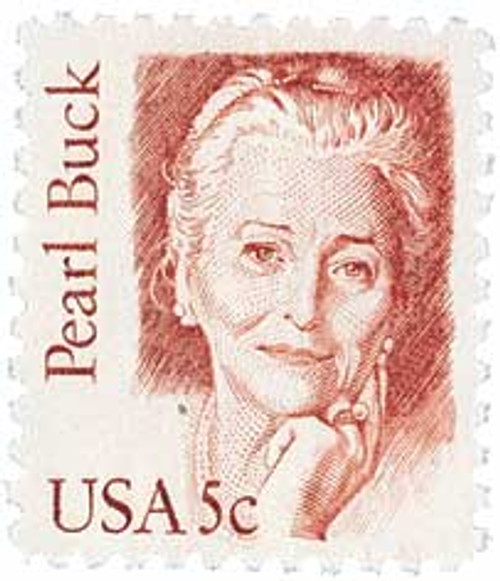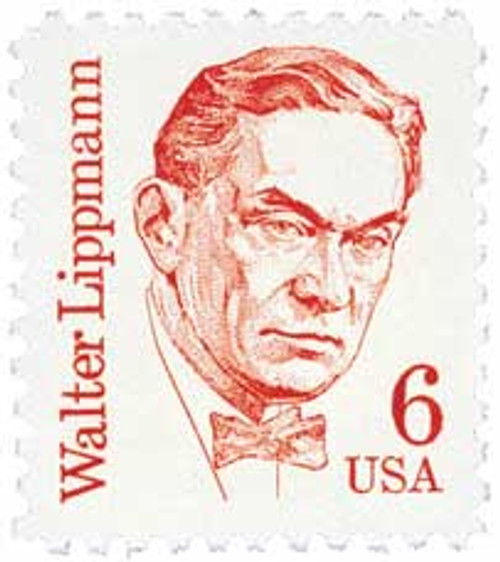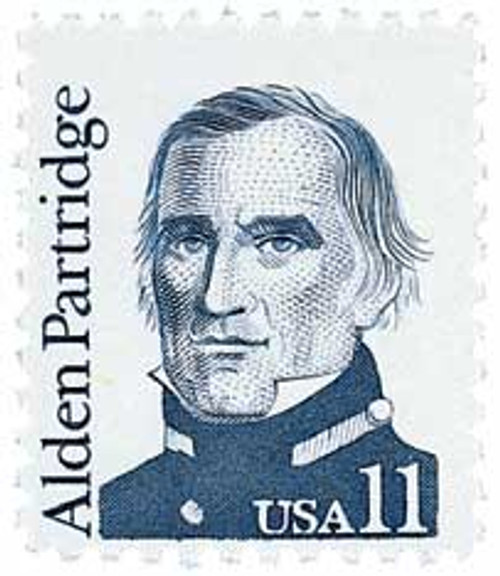
# 2933 FDC - 1995 32c Great Americans: Milton S. Hershey
US #2933
1995 Milton S. Hershey
- Part of Great Americans Series
- Honors founder of Hershey Chocolate Company
Category of Stamp: Definitive
Set: Great Americans
Value: 32¢, First-Class Mail rate
First Day of Issue: September 13, 1995
First Day City: Hershey, Pennsylvania
Quantity Issued: 100,276,000
Printed by: Banknote Corporation of America
Printing Method/Format: Engraved. Panes of 100 (10 across, 10 down), from plates of 400 subjects (20 across, 20 down)
Perforations: 11.2 by 11.1
Color: Chocolate brown
Reason the stamp was issued: The Milton S. Hershey stamp was issued on the 138th anniversary of his birth. It is part of the Great Americans series.
About the stamp design: The oil painting of Hershey used for this stamp was made by commercial illustrator Dennis Lyall. One of the photos used by Lyall for inspiration was of Hershey holding one of the children who benefited from Hershey’s school for orphans.
About the printing process: The stamp was produced by Banknote Corporation of America using two Intaglio (engraved) printing plates, with 400 subjects each.
First Day City: The First Day of Issue ceremony took place in Hershey, Pennsylvania, the town Milton Hershey built for his employees. The September 13, 1995, celebrations included a parade and bands. Those in attendance enjoyed free admission to Hersheypark amusement park, the Hershey Museum, and Hershey’s Chocolate World visitors center. The stamp dedication was attended by 8,000 people. The day ended with a birthday part for Hershey, including chocolate bars and cupcakes.
About the Great Americans Series: The Great Americans Series was created to replace the Americana Series. The new series would be characterized by a standard definitive size, simple design, and monochromatic colors.
This simple design included a portrait, “USA,” the denomination, the person’s name, and in some cases, their occupation or reason for recognition. The first stamp in the new series was issued on December 27, 1980. It honored Sequoyah and fulfilled the new international postcard rate that would go into effect in January 1981.
The Great Americans Series would honor a wider range of people than the previous Prominent Americans and Liberty Series. While those series mainly honored presidents and politicians, the Great Americans Series featured people from many fields and ethnicities. They were individuals who were leaders in education, the military, literature, the arts, and human and civil rights. Plus, while the previous series only honored a few women, the Great Americans featured 15 women. This was also the first definitive series to honor Native Americans, with five stamps.
The Bureau of Engraving and Printing (BEP) produced most of the stamps, but private firms printed some. Several stamps saw multiple printings. The result was many different varieties, with tagging being the key to understanding them. Though there were also differences in perforations, gum, paper, and ink color.
The final stamp in the series was issued on July 17, 1999, honoring Justin S. Morrill. Spanning 20 years, the Great Americans was the longest-running US definitive series. It was also the largest series of face-different stamps, with a total of 63.
History the stamp represents:
Businessman and philanthropist Milton Snavely Hershey was born on September 13, 1857, in Derry Township, Pennsylvania. He was the only surviving child of Mennonites Henry and Fannie Hershey. The family moved often, and he had no formal education after the fourth grade. In 1871, he apprenticed to a local printer, but found the work boring. He was fired after accidentally dropping his hat in one of the machines. While his father asked the printer to give him his job back, his mother and aunt proposed a different apprenticeship – with a candy maker.
When he was 14, Hershey was apprenticed to confectioner Joseph Royer in Lancaster, Pennsylvania. He spent four years there learning the art of creating candy. In 1876, he set out to start his own confectionery business. He traveled to Denver, where he learned to make caramels using fresh milk. Hershey then spent some time in New Orleans, Chicago, and New York, before returning to Lancaster in 1883. There he borrowed money from the bank to start the Lancaster Caramel Company, which was an instant success. Hershey’s secret was pure fresh milk – widely available in his rural town. When a visitor from England tried his candy, he placed a very large order that enabled Hershey to pay off his debt and buy more supplies.
Hershey’s caramel company grew to over 1,300 workers in two factories by the 1890s. During a visit to the 1893 Columbian Exposition, Hershey became fascinated with German chocolate making. He purchased machinery to begin producing chocolate coating for his caramels. Hershey sold his caramel company in 1900 for $1 million (equivalent to more than $30 million today) to the American Caramel Company. He retained the rights to Hershey Chocolate Company however, and broke ground on what would be the world’s largest chocolate manufacturing plant.
Hershey built his factory near Derry Township, where fresh milk was readily available from local farms. He was excited to begin creating his own recipe of milk chocolate, which was a luxury at that time. Using what he had learned in making caramels, Hershey produced his first Hershey’s Bar in 1900. This was followed by the Hershey Kiss in 1907 and the Hershey’s Bar with almonds in 1908.
With success, Hershey felt an obligation to society that he fulfilled by building a model town for his employees. Hershey built a town around his factory unlike any other company town. It included comfortable homes laid out along tree-lined streets, quality public schools, and extensive cultural and recreational opportunities. Soon amusement rides, a swimming pool, and a ballroom were added – paving the way for the Hershey amusement park, which opened in 1906.
Unable to have children of their own, Milton and his wife Catherine established a school for orphan boys. Shortly after Catherine died in 1915, Hershey endowed the school with his entire fortune of Hershey Company Stock – worth approximately $60 million. In 1935, he created the M.S. Hershey Foundation, which offers educational and cultural opportunities to Hershey residents. This funds the Hershey Museum, Hershey Gardens, Hershey Theatre, and the Hershey Community Archives.
During World War II, Hershey provided special chocolate bars for the military serving overseas. First he produced Ration D Bars, that wouldn’t melt in temperatures over 90 degrees. They were also designed to not taste that great, so troops wouldn’t develop cravings for them. After those proved successful, Hershey began producing Tropical Chocolate Bars, which also wouldn’t melt at high temperatures, but had a better taste. It’s believed Hershey supplied soldiers with over three billion chocolate bars during the war. For their contribution, the company received five Army-Navy ‘E’ Production Awards. The Hershey factory also produced some tank parts and machines for the war effort.
Milton Hershey died of pneumonia on October 13, 1945. Even after his passing, profits from the Hershey Company continue to fund several philanthropic endeavors.
US #2933
1995 Milton S. Hershey
- Part of Great Americans Series
- Honors founder of Hershey Chocolate Company
Category of Stamp: Definitive
Set: Great Americans
Value: 32¢, First-Class Mail rate
First Day of Issue: September 13, 1995
First Day City: Hershey, Pennsylvania
Quantity Issued: 100,276,000
Printed by: Banknote Corporation of America
Printing Method/Format: Engraved. Panes of 100 (10 across, 10 down), from plates of 400 subjects (20 across, 20 down)
Perforations: 11.2 by 11.1
Color: Chocolate brown
Reason the stamp was issued: The Milton S. Hershey stamp was issued on the 138th anniversary of his birth. It is part of the Great Americans series.
About the stamp design: The oil painting of Hershey used for this stamp was made by commercial illustrator Dennis Lyall. One of the photos used by Lyall for inspiration was of Hershey holding one of the children who benefited from Hershey’s school for orphans.
About the printing process: The stamp was produced by Banknote Corporation of America using two Intaglio (engraved) printing plates, with 400 subjects each.
First Day City: The First Day of Issue ceremony took place in Hershey, Pennsylvania, the town Milton Hershey built for his employees. The September 13, 1995, celebrations included a parade and bands. Those in attendance enjoyed free admission to Hersheypark amusement park, the Hershey Museum, and Hershey’s Chocolate World visitors center. The stamp dedication was attended by 8,000 people. The day ended with a birthday part for Hershey, including chocolate bars and cupcakes.
About the Great Americans Series: The Great Americans Series was created to replace the Americana Series. The new series would be characterized by a standard definitive size, simple design, and monochromatic colors.
This simple design included a portrait, “USA,” the denomination, the person’s name, and in some cases, their occupation or reason for recognition. The first stamp in the new series was issued on December 27, 1980. It honored Sequoyah and fulfilled the new international postcard rate that would go into effect in January 1981.
The Great Americans Series would honor a wider range of people than the previous Prominent Americans and Liberty Series. While those series mainly honored presidents and politicians, the Great Americans Series featured people from many fields and ethnicities. They were individuals who were leaders in education, the military, literature, the arts, and human and civil rights. Plus, while the previous series only honored a few women, the Great Americans featured 15 women. This was also the first definitive series to honor Native Americans, with five stamps.
The Bureau of Engraving and Printing (BEP) produced most of the stamps, but private firms printed some. Several stamps saw multiple printings. The result was many different varieties, with tagging being the key to understanding them. Though there were also differences in perforations, gum, paper, and ink color.
The final stamp in the series was issued on July 17, 1999, honoring Justin S. Morrill. Spanning 20 years, the Great Americans was the longest-running US definitive series. It was also the largest series of face-different stamps, with a total of 63.
History the stamp represents:
Businessman and philanthropist Milton Snavely Hershey was born on September 13, 1857, in Derry Township, Pennsylvania. He was the only surviving child of Mennonites Henry and Fannie Hershey. The family moved often, and he had no formal education after the fourth grade. In 1871, he apprenticed to a local printer, but found the work boring. He was fired after accidentally dropping his hat in one of the machines. While his father asked the printer to give him his job back, his mother and aunt proposed a different apprenticeship – with a candy maker.
When he was 14, Hershey was apprenticed to confectioner Joseph Royer in Lancaster, Pennsylvania. He spent four years there learning the art of creating candy. In 1876, he set out to start his own confectionery business. He traveled to Denver, where he learned to make caramels using fresh milk. Hershey then spent some time in New Orleans, Chicago, and New York, before returning to Lancaster in 1883. There he borrowed money from the bank to start the Lancaster Caramel Company, which was an instant success. Hershey’s secret was pure fresh milk – widely available in his rural town. When a visitor from England tried his candy, he placed a very large order that enabled Hershey to pay off his debt and buy more supplies.
Hershey’s caramel company grew to over 1,300 workers in two factories by the 1890s. During a visit to the 1893 Columbian Exposition, Hershey became fascinated with German chocolate making. He purchased machinery to begin producing chocolate coating for his caramels. Hershey sold his caramel company in 1900 for $1 million (equivalent to more than $30 million today) to the American Caramel Company. He retained the rights to Hershey Chocolate Company however, and broke ground on what would be the world’s largest chocolate manufacturing plant.
Hershey built his factory near Derry Township, where fresh milk was readily available from local farms. He was excited to begin creating his own recipe of milk chocolate, which was a luxury at that time. Using what he had learned in making caramels, Hershey produced his first Hershey’s Bar in 1900. This was followed by the Hershey Kiss in 1907 and the Hershey’s Bar with almonds in 1908.
With success, Hershey felt an obligation to society that he fulfilled by building a model town for his employees. Hershey built a town around his factory unlike any other company town. It included comfortable homes laid out along tree-lined streets, quality public schools, and extensive cultural and recreational opportunities. Soon amusement rides, a swimming pool, and a ballroom were added – paving the way for the Hershey amusement park, which opened in 1906.
Unable to have children of their own, Milton and his wife Catherine established a school for orphan boys. Shortly after Catherine died in 1915, Hershey endowed the school with his entire fortune of Hershey Company Stock – worth approximately $60 million. In 1935, he created the M.S. Hershey Foundation, which offers educational and cultural opportunities to Hershey residents. This funds the Hershey Museum, Hershey Gardens, Hershey Theatre, and the Hershey Community Archives.
During World War II, Hershey provided special chocolate bars for the military serving overseas. First he produced Ration D Bars, that wouldn’t melt in temperatures over 90 degrees. They were also designed to not taste that great, so troops wouldn’t develop cravings for them. After those proved successful, Hershey began producing Tropical Chocolate Bars, which also wouldn’t melt at high temperatures, but had a better taste. It’s believed Hershey supplied soldiers with over three billion chocolate bars during the war. For their contribution, the company received five Army-Navy ‘E’ Production Awards. The Hershey factory also produced some tank parts and machines for the war effort.
Milton Hershey died of pneumonia on October 13, 1945. Even after his passing, profits from the Hershey Company continue to fund several philanthropic endeavors.

















